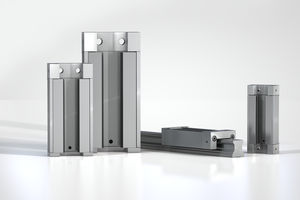
- Products
- Catalogs
- News & Trends
- Exhibitions
Pneumatic clamping element LOCKED PRKhydraulicelectriccompact
Add to favorites
Compare this product
Characteristics
- Type
- pneumatic, hydraulic, electric
- Other characteristics
- compact
- Clamping force
Min.: 0 N
Max.: 5,000 N
Description
Rod clamping with maximum clamping force in a compact size
Pneumatic Rod Clamping, Compact
Holding torque 62 in-lbs to 885 in-lbs
Compact and safe: when space becomes restricted, the compact LOCKED PRK clamping elements come into their own. For pneumatic rod clamping with low heights of 28 mm to 34 mm (1.10 to 1.34 in), they provide clamping forces of up to 1,124 lbs (5000 N).
Clamping is carried out by a diaphragm spring-plate system and is released when compressed air is applied. Clamping elements from the LOCKED PRK product family absorb the forces on rods with diameters between 20 mm and 40 mm (0.79 and 1.57 in) both axially and rotationally. The function makes them suitable for use as static clamping without pressure, because the failure or drop of pneumatic pressure triggers immediate clamping. High clamping forces with low system costs compared with hydraulic and electric solutions make these clamping elements particularly interesting.
LOCKED PRK models are used in automation and machine building and customized machine tools.
TECHNICAL DATA
Holding torque 62 in-lbs to 885 in-lbs
Rod diameter Ø 0.79 in to Ø 1.57 in
Clamping cycles 1,000,000
Mounting In any position
Material Outer body: Tool steel
Pneumatic medium Dried, filtered air
Operating temperature range 50 °F to 113 °F
Application field Jacking systems, Light presses, Punching/stamping machines, Stacking units
NOTE
When mounting, use hardened piston rod.
ON REQUEST
Special designs as for example special diameters and accessories available on request.
Catalogs
Damping Technology
306 Pages
*Prices are pre-tax. They exclude delivery charges and customs duties and do not include additional charges for installation or activation options. Prices are indicative only and may vary by country, with changes to the cost of raw materials and exchange rates.



